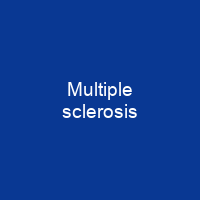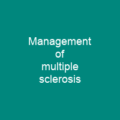Multiple sclerosis is the most common immune-mediated disorder affecting the central nervous system. Specific symptoms can include double vision, blindness in one eye, muscle weakness and trouble with sensation or coordination. There is no known cure for multiple sclerosis. Treatments attempt to improve function after an attack and prevent new attacks. Medications used to treat MS can have side effects and be poorly tolerated.
About Multiple sclerosis in brief

The main measure of disability and severity is the expanded disability status scale, with other measures such as the multiple sclerosis functional composite being increasingly used in research. Many factors are likely to affect relapse rates including vaccination, breast feeding, physical trauma, and physical trauma. People may start in a relapses and remitting course that then become progressive later on. The disease usually begins between the ages of twenty and fifty and is twice as common in women as in men. It is thought to be either destruction by the immune system or failure of the myelin-producing cells. The specific symptoms are determined by the locations of the lesions within the nervous system, and may include loss of sensitivity or changes in sensation such as tingling, pins and needles or numbness, blurred vision, very pronounced reflexes, muscle spasms, or difficulty in moving; problems with speech or swallowing, visual problems, feeling tired, acute or chronic pain, and bladder and bowel difficulties, among others. Some relapses are preceded by triggers, such as common cold, influenza, or gastroEnteritis. Relapses are more common during spring and summer and they occur more frequently during the first months of the year. Women who become pregnant with MS are at higher risk of having an attack with fewer relapses during first months after delivery, however, there is no evidence that pregnancy does not seem to influence long- term disability.
You want to know more about Multiple sclerosis?
This page is based on the article Multiple sclerosis published in Wikipedia (as of Dec. 03, 2020) and was automatically summarized using artificial intelligence.







